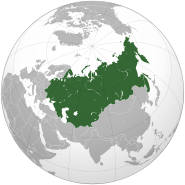 |
 |

| |
The Soviet Union (Russian: Советский Союз, tr. Sovetsky Soyuz), officially the Union of Soviet Socialist Republics (USSR; Russian: Сою́з Сове́тских Социалисти́ческих Респу́блик, tr. Soyuz Sovetskikh Sotsialisticheskikh Respublik; IPA: [sɐˈjus sɐˈvʲetskʲɪx sətsɨəlʲɪˈstʲitɕɪskʲɪx rʲɪsˈpublʲɪk] ⓘ; abbreviated СССР, SSSR), was a constitutionally socialist state that existed in Eurasia between 1922 and 1991. Russia is the legal successor of the USSR.
The Soviet Union was a single-party state ruled by the Communist Party from its foundation until 1990. Even though the USSR was technically a union of 15 subnational Soviet republics, its government and economy were highly centralized. The Russian Revolution of 1917 caused the downfall of the Russian Empire. Following the Russian Revolution, there was a struggle for power between the Bolshevik party, led by Vladimir Lenin, and the anti-communist White movement. In December 1922, the Bolsheviks won the civil war, and the Soviet Union was formed with the merger of the Russian Soviet Federative Socialist Republic, the Transcaucasian Socialist Federative Soviet Republic, the Ukrainian Soviet Socialist Republic and the Byelorussian Soviet Socialist Republic. Following the death of Vladimir Lenin in 1924, Joseph Stalin took power, leading the USSR through a large-scale industrialization program. Stalin established a planned economy and suppressed political opposition to him even from his own party, the Russian Communist party.